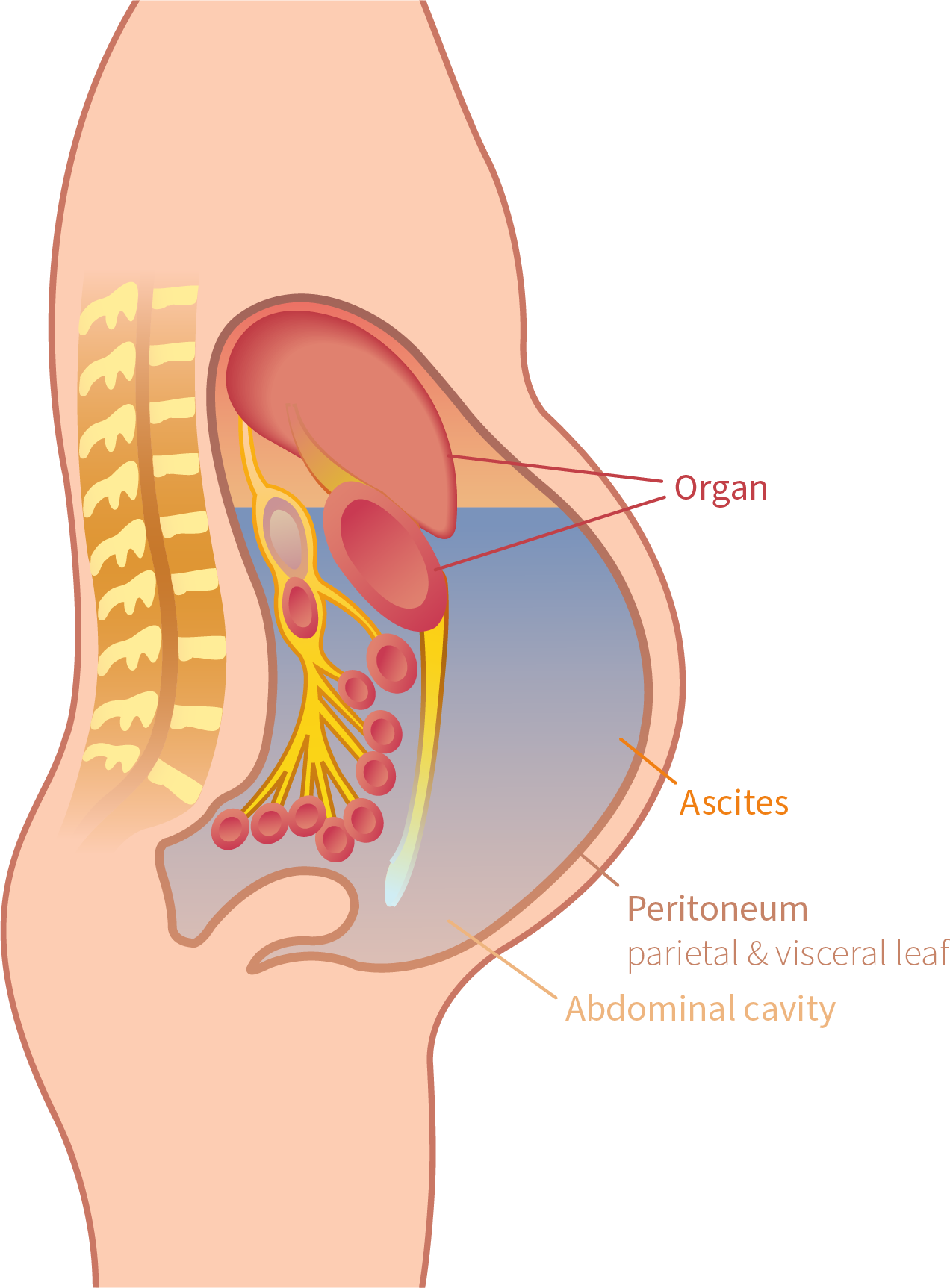Ascites / water in the abdomen
Explained in an understandable way!
SHORT & CUTTLE
Most common causes of ascites
- Cancer
- Liver cirrhosis
- Heart failure
Ascites symptoms
- Feeling of pressure in the abdomen
- Pain in the abdomen
- Digestive difficulties
- Increase in the circumference of the abdomen
- Shortness of breath
- Gait unsteadiness (sway)
Synonyms for ascites
- Abdominal fluid
- Water belly
- Abdominal dropsy
Ascites treatment
- Puncture
- Implantable pump system
- Permanent drainage catheter
The peritoneum (abdominal membrane)
The peritoneum is a thin skin around the abdomen. The peritoneum is divided into two sheets. On the one hand, the parietal sheet covers the abdominal wall from the inside, and on the other hand, the visceral sheet covers the abdominal organs.
The peritoneum has two major functions. On the one hand, it provides protection for the organs in the abdominal cavity. On the other hand, it ensures the necessary mobility of the organs with the production of a fluid.

Professor Scheule explains simply -What is malignant ascites (abdominal fluid)?

Mit dem Laden des Videos akzeptieren Sie die Datenschutzerklärung von YouTube.
Mehr erfahren
Professor Scheule explains simply -What is liver-related ascites?

Mit dem Laden des Videos akzeptieren Sie die Datenschutzerklärung von YouTube.
Mehr erfahren
What is ascites?
Ascites (abdominal fluid) is the accumulation of fluid in the abdominal cavity. In the process, the abdominal girth visibly increases, and there may be feelings of pressure, pain, digestive difficulties and breathing problems.
What causes ascites?
Ascites can have various causes. Cancer, cardiac insufficiency or inflammation of the intestines, to name but a few, can cause ascites. Also a cirrhosis of the liver in an advanced stage causes an accumulation of water in the abdominal cavity as a typical symptom.

For me, the drainage system is a piece of quality of life that I have regained. I can connect the bag directly without much effort and take it off again after drainage.
– Mrs. S. from Kleinmachnow / ascites –
For me, the drainage system is a piece of quality of life that I have regained. I can connect the bag directly without much effort and take it off again after drainage.
– Mrs. S. from Kleinmachnow / ascites –
How is an effusion treated?
How is an effusion treated?
In addition to treatment of the underlying disease, ascites can be treated with the following therapies, depending on the cause:
Professor Scheuleexplains simply -Treatmen-of ascites?

Mit dem Laden des Videos akzeptieren Sie die Datenschutzerklärung von YouTube.
Mehr erfahren
In addition to treatment of the underlying disease, ascites can be treated with the following therapies, depending on the cause:
Ascites puncture
Ascites puncture is an outpatient procedure that often must be performed in the clinic outpatient department. In this process, the accumulated fluid is drawn off via a cannula using a syringe.
Implantable pump
Another option is an implantable pump, which is used in a surgical procedure under general anesthesia and continuously pumps fluid into the bladder through a catheter. The fluid is then excreted with the urine.
Permanent drainage
However, we at ewimed recommend immediate placement of a permanent drainage catheter in case of recurrent effusions.
A permanently placed catheter has the advantage for the patient that he or she does not have to repeatedly visit the clinic outpatient department or the physician to be punctured. The patient thus has more time available, as the drainage can be performed without the presence of a physician, thus increasing his mobility and quality of life again.
Other advantages of a permanent catheter are shorter hospital stays, a reduced risk of infection and a very low complication rate (proven by scientific studies).
Professor Scheule explains simply -Treatment options for ascites?

Mit dem Laden des Videos akzeptieren Sie die Datenschutzerklärung von YouTube.
Mehr erfahren
The advantages of the ewimed drainage systems at a glance
- independent, fast and safe drainage possible at home
- No further hospitalizations
- Simple and intuitive handling
- no repeated, painful punctures
- one-time, minimally invasive procedure for implantation of the catheter
- highest safety standards due to key-lock principle of the catheter with reservoir
- Increased mobility and independence for you as a patient
- Reduction of the risk of infection
Do you have any questions?
Contact us now or find a selection of frequently asked questions from patients here.
Do you have any questions?
Contact us now or find a selection of frequently asked questions from patients here.

